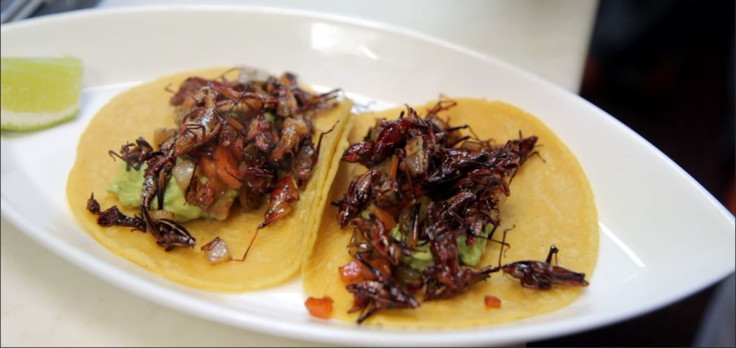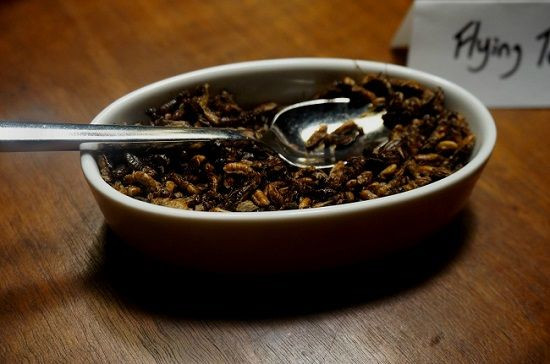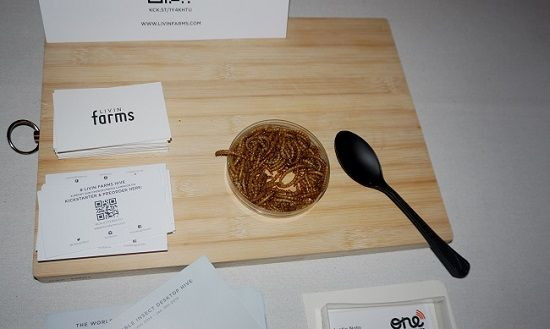Bug Bites: I Ate Insects With Every Meal For A Week

From afar, they looked like the sort of party mix you'd find at your typical freshman college orientation — adequate if uninspired.
As I scooped up a bunch from a chrome-colored, dry-sealed bag and brought them up to eye level, though, that feeling of blandness quickly dissipated and a more macabre sensation at the bottom of my guts kicked in. I was staring at roasted crickets and in little less than a second, their crunchy bodies would be introduced to every last surface of my mouth.
So began my journey to the weird world of entomophagy, more unnervingly known as the practice of eating insects. For a week, I went on an editor-mandated diet of bugs, bugs, and more bugs. And it wasn’t so bad at all. Below are some more lessons and factoids I took away from my experience.
There are more than 1,900 insect species in the world that are considered edible, according to the UN, and two billion people include insects in their diet at least part of the year, often timed by the appearance of the rainy season. There are also ongoing efforts to further promote insects as a food source, particularly in developing nations.
The most commonly eaten bugs worldwide are beetles, followed by caterpillars. In the U.S., however, (house) crickets are often the gateway bug of choice for many insect start-ups and farms. "There's a built-in accessibility with crickets as opposed to other insects," Lucy Knops, one-half of the team behind Critters Bitters, a cocktail bitter made with crickets, told Medical Daily. Some estimates place crickets to be worth 21 grams of protein per 100 grams of cooked weight, compared to 26 grams of protein per 100 grams for cows. They’re also richer in Omega 3s while roughly having the same amount of iron. Oher research has found similarly superior nutritional benefits for insects such as honey bees, silkworms, and palm weevils, among others.
One of these start-ups is Bitty Foods, whose cricket baking flour I ordered online and used to make myself daily pancakes and the occasional battered fish fry. For those interested, they also sell premade cricket cookies in three flavors. My aforementioned roasted crickets were bought from Entomarket.com, where I also treated myself to several mealworm (the larval form of the mealworm beetle) packs. Both served as a side platter for most of my homecooked meals.

For those interested in the “restaurant bugs” I ate, you can travel out to New York City and order Toloache’s chapulines, a taco blend containing grasshoppers, onions, cilantro, jalapeño, salsa verde. It’s a recipe inspired by the customary practice of eating grasshoppers in Oaxaca, Mexico. Left unmentioned in the video above is how amazing they tasted when mixed with plain old tortilla chips.
Farming insects is believed to require far less environmental resources, such as water, than it would for conventional animals. In particular, according to the UN, crickets are twice as efficient in converting feed to meat as chicken, at least four times more efficient than pigs, and 12 times more efficient than cattle. All while emitting far less greenhouse gases.
The benefits of insect farming aren’t entirely settled, though. A 2015 PLOS-One study found successfully raising crickets on a large scale basis would require the same quality of grain feed as raising broiler chickens would. Attempts to raise crickets using left behind food waste also didn’t go as well as planned, either. “Therefore, the potential for crickets to supplement the global supply of dietary protein appears to be more limited than has been recently suggested,” the authors concluded.

The hardest part of my bug diet wasn’t eating them so much as it was actually finding them in the first place. Aside from Bitty Foods and Entomarket, there are relatively scarce places where an average person can buy edible bugs or foods mostly made with bugs — even online. These foods also tend to be much more expensive than their non-insect counterparts. One case of cricket cookies from Bitty Foods costs $20 with shipping, for example.
The landscape of entomophagy is quickly changing, however. This upcoming spring will feature the formal debut of Critter Bitters, after Knops and her partner Julia Plavin successfully raised $25,477 on Kickstarter this past winter. So far, the pair estimate anywhere from 500 to 1,000 people have already tried their product out, a “nutty, honey-like” blend of ingredients that nevertheless doesn’t shy from showing off its namesake.
Another Kickstarter success, the European-based Livin’ Farms Hive, will begin sending their product to consumers in November. For $650, you can preorder a desktop farm that easily raises mealworms for you using kitchen scraps. You can even buy an accompanying cookbook. “Most people feel comfortable with it once they understand the lifecycle. The Hive makes people confident that insects are nothing to worry about.” Katharina Unger, founder & CEO of Livin’, told Medical Daily. “We are also building a platform so that people can share their experiences, read up on recipes and build a new food culture.”
Of all the bug-themed foods I tried out, Bitty Foods' chocolate chip cookies were my favorite, though the Livin' Farm Hive mealworms were a close second. Least favorite? Flying termites and sago worms.



























